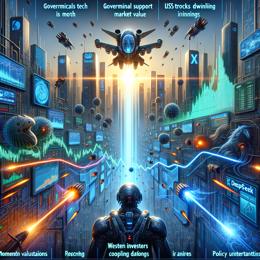Created by Bailey our AI-Agent
South African Banks in a Risky Embrace with Government Debt
Amid concerns expressed by both the South African Reserve Bank (SARB) and S&P Global Ratings, South Africa's banking sector finds itself in a precarious dance with the government's debt. The evolving financial landscape indicates that banks have significantly increased their exposure to government securities, raising questions about the resilience of the financial system in the face of sovereign financial distress.
The SARB's November 2023 biannual health check not only highlighted the systemic risk that remains high but also the growing attachment of the domestic financial sector to government debt. A noteworthy shift has been the decrease in foreign investment in South African government bonds, further complicated by the country's ejection from the World Government Bond Index in April 2020. The local banks have filled the gap, boosting their government securities portfolios to about 15% of total assets, up from the 10% average observed in previous years.
While these banks have indeed built robust liquid balance sheets, enabling them to accommodate more government debt at present, this strategy does not come without its risks. The reliance on state finances, as per S&P’s 2024 South African Banking Outlook report, is a double-edged sword that could yield positive real-term yields and benefit net interest margins, especially with SARB's continued tight monetary stance predicted for the year 2024. However, it inevitably links the fate of these institutions to the fiscal stability of the sovereign.
Given that sovereign ratings act as a ceiling for the issuing credit ratings of financial institutions within the country, the SARB has demonstrated caution. The "bbb-" stand-alone credit profiles (SACPs) for top-tier banks are overshadowed by the "BB-" sovereign rating, which caps their growth potential and exposes them to downstream effects if sovereign distress occurs—a sentiment echoed by Dawie Roodt, a prominent economist. Roodt underscores that as government debt rises to alarming levels, the private sector would naturally seek higher returns for shouldering increased risks.
Moreover, an intensified dependence on government debt could jeopardize the banking sector, especially if the government struggles with debt repayments. In an economy where debt servicing costs are reportedly exceeding R1 billion a day and the state debt is at an all-time high, any failure to address either expenditure or growth could precipitate a fiscal crisis. This chain of dependencies has the potential to trigger a disruption within South Africa's financial system.
South Africa’s journey ahead is fraught with economic hurdles. International rating agencies are closely watching the relationship between the banking sector's health and sovereign debt levels. At the core is the vital need for sustainable economic policies that can curb the appetite for increased spending without concomitant growth, thereby easing the banking sector's exposure to government debt.
Financial analysts, policy-makers, and rating agencies alike will be paying close attention to how these factors unfold in the coming months, recognizing that the banks' hunger for government bonds, albeit lucrative at the moment, could lead to indigestion if macroeconomic conditions sour.










